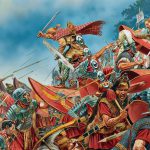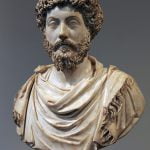Dacians and Getae were related barbarian tribes that had rivalled the Romans many times throughout history. They inhabited the territory of present-day Romania, Bulgaria, Hungary, Moldova, Slovakia and even Ukraine. Their greatest advantage was sudden raids on Roman territories, which used the element of surprise, including extremely effective cavalry.
One of the most common directions of Dacian attacks was the border on the Danube (especially on the ice in winter) and plundering areas deep as far as Greece. For this purpose, Roman limes were first observed and in the case of a small number of Roman soldiers in a given area, an attack was launched. Interestingly, the Romans, although they treated them as enemies, often recruited mercenaries from Dacian tribes, knowing the strength and ruthlessness of Dacian warriors. The Getae used similar tactics as the Dacians, but they mainly raided the coastal cities of the Black Sea. The Romans were aware of the threat and tried to keep the Dacians as far away from the borders as possible. Often, in order to avoid danger, it was decided to pay (stipendium).
Why the numerous barbarian raids on Roman lands? First of all, they had plundering purposes (slaves, food, precious goods, weapons). The most difficult moment of the invasion was the return of the troops with loot to their own lands. For this purpose, the armies often split up earlier and attacked the Romans’ supply and strategic places to delay their possible counterreaction. During the return with the loot, wagons and slaves were led between cavalry units.
Another reason for the invasion was that the barbarian chieftains were looking for a way to gain the applause of the community and prove their bravery and effective leadership. Moreover, the strongly growing population and thus a greater number of warriors meant that the chiefs were looking for a way to reduce tensions in the community, and thus avoid unrest and upheavals.
Both the Getae and the Dacians used heavy cavalry, armed with long lances, and horse archers who supported the attack. Attacks on cities were carried out either with the help of spies or with intensive assault. After capturing the city, the warriors did not spare anyone, hence there was so much terror before their raids.
One of the most famous and successful Dacian expeditions was the invasion of Roman lands in the winter of 85 CE, during the reign of Domitian. According to ancient sources, the reason for the expedition was the greed of the Dacian leader Decebal. The Romans are said to have been completely surprised by the invasion. As a result of the Dacian expedition, the governor of Moesia, Gaius Oppius Sabinus, was killed, and many troops and forts were destroyed. Moreover, a lot of loot was taken from the Roman lands, and finally, the Dacians were pushed across the river only after Domitian was directly involved in the events in the region. Regardless, the Dacian invasion caused heavy losses and chaos in Roman lands.
This event, as well as many other attacks in the 1st century CE, motivated Emperor Trajan to carry out a counterattack. The next two Dacian wars, at the beginning of the 2nd century CE, eliminated for a certain period the problem of the threat of barbarian invasions across the Danube.







